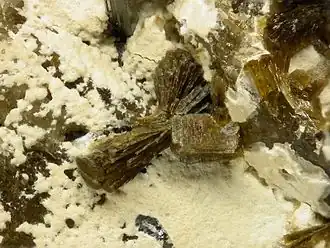Greifensteinite
| Greifensteinite | |
|---|---|
 Greifensteinite (picture size: 3 mm) | |
| General | |
| Category | Phosphate mineral Roscherite group |
| Formula | Ca2Fe2+5Be4(PO4)6(OH)4·6H2O |
| IMA symbol | Gfs[1] |
| Strunz classification | 8.DA.10 |
| Dana classification | 42.7.7.4 |
| Crystal system | Monoclinic |
| Crystal class | Prismatic (2/m) (same H-M symbol) |
| Space group | C2/c |
| Unit cell | a = 15.903, b = 11.885 c = 6.677 [Å]; β = 94.68°; Z = 2 |
| Identification | |
| Color | Yellow green, olive green, light brown |
| Crystal habit | Prismatic |
| Cleavage | Good on {100} (or parting on {100})[2] |
| Fracture | Uneven |
| Tenacity | brittle |
| Mohs scale hardness | 4.5 |
| Luster | Vitreous |
| Streak | White, greenish |
| Diaphaneity | Transparent to translucent |
| Specific gravity | 2.93 |
| Optical properties | Biaxial (-) |
| Refractive index | nα: 1.624 nβ: 1.634 nγ: 1.638 |
| Birefringence | 0.014 |
| 2V angle | 80° |
| References | [2][3][4] |
Greifensteinite is beryllium phosphate mineral with formula: Ca2Fe2+5Be4(PO4)6(OH)4·6H2O. It is the Fe2+ dominant member of the roscherite group.[5] It crystallizes in the monoclinic crystal system and typically forms prismatic dark olive green crystals.[2]
It was first described in Germany at Greifenstein Rocks, Ehrenfriedersdorf, and was named for the location. At the type locality, it occurs within a lithium-rich pegmatite in miarolitic cavities. It was approved by the International Mineralogical Association in 2002.[2]
References
- ^ Warr, L.N. (2021). "IMA–CNMNC approved mineral symbols". Mineralogical Magazine. 85 (3): 291–320. Bibcode:2021MinM...85..291W. doi:10.1180/mgm.2021.43. S2CID 235729616.
- ^ a b c d Greifensteinite data on Webmineral
- ^ Mindat.org
- ^ Mineralienatlas
- ^ Roscherite group on Mindat.org
- Rastsvetaeva R K, Gurbanova O A, Chukanov N V (2006) Crystal structure of greifensteinite Ca2Fe2+☐Mg2Fe2+2Be4(PO4)6(OH)4·6H2O. Doklady Chemistry 41, 18-25 [1]